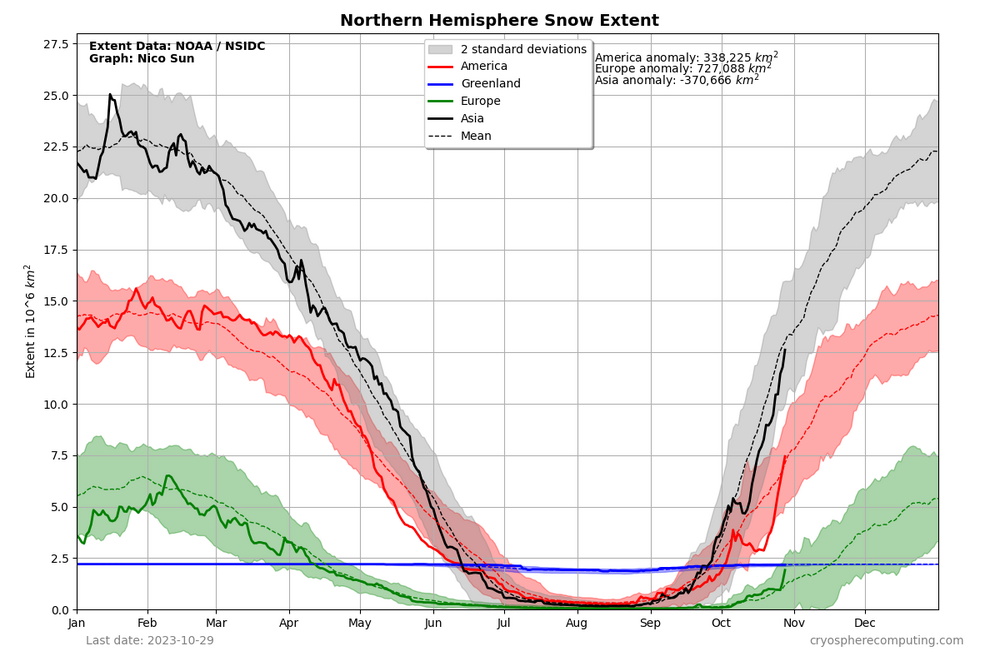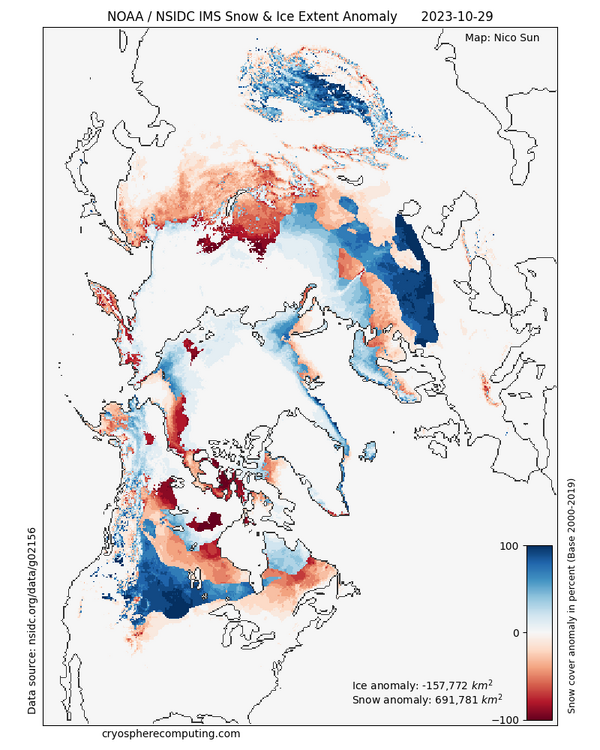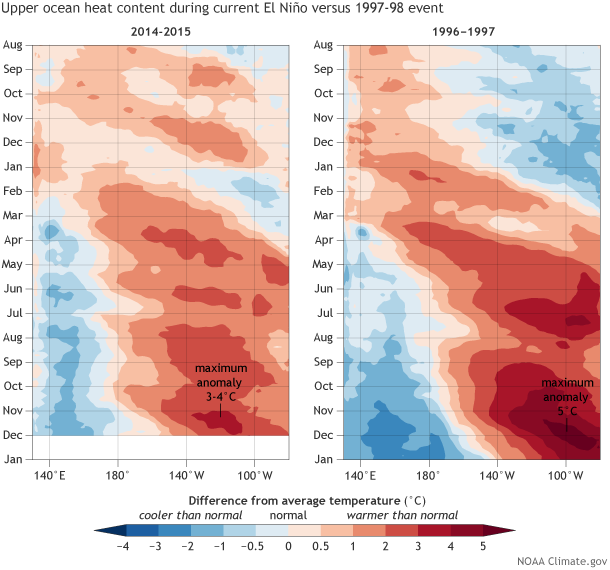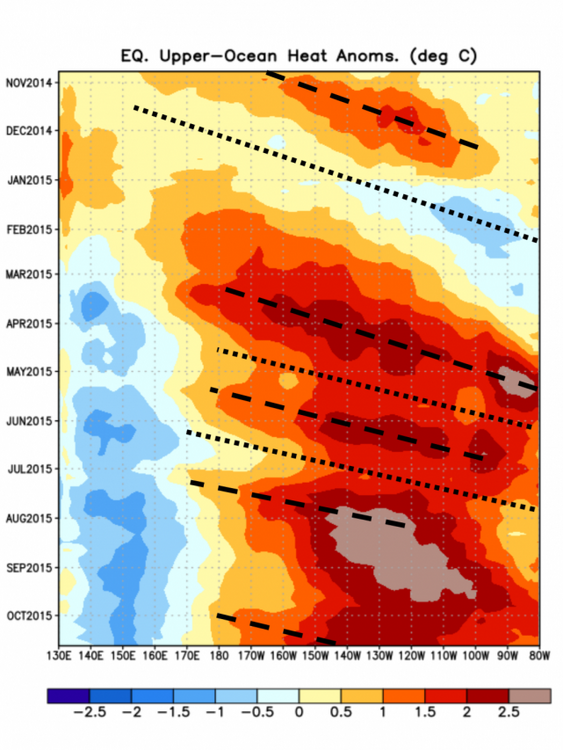
so_whats_happening
Meteorologist-
Posts
1,442 -
Joined
-
Last visited
Content Type
Profiles
Blogs
Forums
American Weather
Media Demo
Store
Gallery
Everything posted by so_whats_happening
-
El Nino 2023-2024
so_whats_happening replied to George001's topic in Weather Forecasting and Discussion
I mean there is a point to be made that there is some similarity to 97 atmospherically right now. Biggest difference that stands out is the higher heights on the west coast/ BC region which were the exact opposite in 1997. That will certainly be something to continue to watch as we move forward. Maybe a weaker Aleutian version of 1997 would make for an interesting year. There are some other flavors of Super Nino mixed in there from past events. Edit: had to go and emphasize some because a few may misconstrue the idea. -
El Nino 2023-2024
so_whats_happening replied to George001's topic in Weather Forecasting and Discussion
This seems to be an ongoing theme of late the troposphere kinda doing it's own thing from time to time and the Strat trying to couple but failing do so more often then not. -
El Nino 2023-2024
so_whats_happening replied to George001's topic in Weather Forecasting and Discussion
Did from mid month to the most recent plot. Looks like we finally are getting a more pronounced cooling look in the WPAC. We are shifting the anomalies located around the dateline eastward and having less of a cool pool under 3.4. Still nothing major to speak of as of yet but this does help explain the slight uptick in Upper ocean anomalies @GaWx had posted about the other day. I do not believe we will go over the last two peaks we saw but this will allow for warmer waters to spread out a bit more again giving that probable push close to 2C through November for 3.4. Still not seeing it go much above that as we move forward and I think we would need an East propagating WWB event to occur in time if something can manifest itself to push north of that 2C mark. -
El Nino 2023-2024
so_whats_happening replied to George001's topic in Weather Forecasting and Discussion
Fairly good, it is not recommended to go past hr 240 though. -
El Nino 2023-2024
so_whats_happening replied to George001's topic in Weather Forecasting and Discussion
Because that shows anomalies not an index so yes they are different. -
El Nino 2023-2024
so_whats_happening replied to George001's topic in Weather Forecasting and Discussion
Im not sure what constitutes a good snowfall cover season over another but we have seen buildup decent since the beginning of October to be just below average currently. As for sea ice the Pacific side and CAA is suffering a little but the Atlantic front is surprisingly strong right now. https://cryospherecomputing.com/ Edit: you can see where the ridging has been most of the summer which seems to be where some of the anomalous ice deficit has shown up with the re-freeze. -
El Nino 2023-2024
so_whats_happening replied to George001's topic in Weather Forecasting and Discussion
Here was the U total at 850 during the long late January to end of February WWB event. This also created one of these largest amplitudes of region we have seen in a very long time. The resulting subsurface and I stopped it just before the secondary smaller event took place in April. This should be able to support a +2C reading at some point (maybe mid November to mid December?) That would yield a potential trimonthly max around 1.7-1.8 when all is said and done the question comes what happens after this. Im just not sure though the longevity of such an event my guess is a month at best unless we see continual WWB activity show up through much of November but again im not seeing temp potential of 2.1-2.3 out of this. I can make a gif tomorrow of this lead up thus far from mid Oct to now. From my quick look it tends to take about 2 weeks to get a solid reaction out of an event. Take for instance the WWB in the EPAC in early March it did not show up until the March 20 time frame on TAO. -
El Nino 2023-2024
so_whats_happening replied to George001's topic in Weather Forecasting and Discussion
Yea I guess we are seeing what will come of a west propagating WWB, typically this goes east over time as a decent anomaly across all regions but there is a rather weak response further east than you would want to see. GFS also had that second WWB maxima about the first week of November since has weakened it most likely in response to an Equatorial Rossby wave taking shape again and spawning maybe dual cyclones again? A push to 2C in 3.4 is not out of the realm of possibility but the ability for it sustain itself is another thing. -
El Nino 2023-2024
so_whats_happening replied to George001's topic in Weather Forecasting and Discussion
Cant argue the MJO or the Nino/+IOD look those are well seen at this point. Walker circulation needs some work probably in a more neutral position look overall. The first image you see when scrolling down, of course it is for DJF but the look still remains. https://www.climate.gov/news-features/blogs/enso/walker-circulation-ensos-atmospheric-buddy As for WWB's this is certainly no massive event. We have seen these levels and actually stronger earlier in the event. It also remains to be seen whether this was it or not for the WWB's going forward a couple days ago models were showing another potential in the first week of November but have since lost it. Let us wait another week or so to see the results of what just happened before we start saying it is off to the races or it levels off. -
El Nino 2023-2024
so_whats_happening replied to George001's topic in Weather Forecasting and Discussion
Just for reference from the last two super Ninos. Edit to add 2015 specifically as I do not have 1997. -
El Nino 2023-2024
so_whats_happening replied to George001's topic in Weather Forecasting and Discussion
So here was the large WWB event from the mid to end of May we saw the effects in about 2 weeks start to be noticeable in the subsurface configuration after the WWB took place. So far this one was a bit further east than the one that took place mid to late May. About the same magnitude but also had easterly progression from an event in May around 90-100E. This is typically how I see a WWB going to help relocate warmer waters further east and allow subsequent cooling to occur in its wake. This probably was the stepping stone to where we are with getting the +IOD to form as well as the final nudge in August which was an even slightly further east WWB event. Mind you nothing has stirred up east of the dateline to date but the weakening of trades definitely spread across Nino regions from not only the WPAC WWB but a minor EPAC WWB working in tandem. Now it is possible we see something in similar fashion take place but with yet again further east placement of this new WWB. Although again I am unsure what a west propagating WWB means in warming ( guess we will find out) overall though OHC in the 100-180 region didn't move all that much even with the large WWB event in May and August. Can also do one leading up to August and past the August event if folks are interested. This alone is the reason I do see us going to +2C for a bit but I do not for see it sustaining itself long let alone getting much above that as we move forward. Again I only see the warmth maybe lasting a month at best and that may be giving it more credit than I should. -
El Nino 2023-2024
so_whats_happening replied to George001's topic in Weather Forecasting and Discussion
September and October I believe will end up about the same as far as monthly means go. As for peak I do not believe this has occurred yet. I still do see about a months worth of floating around 2C this will help nudge the ONI up but still be below that 2C trimonthly that has been floating around for sometime. OND peak is likely and we will have to wait and see what happens after we get into November, but if we continue on the path we have there is about a 2-2.5 month difference in between large WWB events over the entire life of this Nino. This would put another around early January which would most likely just help drag out the Nino instead of it collapsing but that is to be determined. I personally feel this is the last solid push we will see with this Nino event so it better be a big one to get even remotely close to a super trimonthly average. -
El Nino 2023-2024
so_whats_happening replied to George001's topic in Weather Forecasting and Discussion
Been trying to remember to save these as well since it shows a broader look of the Pacific. -
El Nino 2023-2024
so_whats_happening replied to George001's topic in Weather Forecasting and Discussion
Very cool to see the bounce between the 2 hemispheres given fairly similar situations, only thing is we have a stronger nino this year. Can i find this on BOM website? -
El Nino 2023-2024
so_whats_happening replied to George001's topic in Weather Forecasting and Discussion
Temp trends for a few days now have been showing warming taking place near Java/Sumatra. That is all i simply pointed out. This would reduce the temp difference across the IO and thus start to lower IOD values going forward. You would need a rather dramatic reversal in the next 2 weeks to start a replenishment of the cooler upwelling waters. With trade wind forecasts showing up more into the central IO and weakening as we move to November im not sure we see much more increase. Even some models show a peak in november area as you just posted. So it wouldnt be too far fetched to think peak has been reached. -
El Nino 2023-2024
so_whats_happening replied to George001's topic in Weather Forecasting and Discussion
Yea I am sure with enough digging around one could find a database with daily/ weekly values or something along those lines. -
El Nino 2023-2024
so_whats_happening replied to George001's topic in Weather Forecasting and Discussion
Yea Im still not sure what to make of the IOD for our area I have found it rather irrelevant but in the indo-pacific and Africa region definitely an instrument that needs to be watched for them. Definitely feels like a byproduct of Nina/Nino development but not everyone follows similarly in path so... As for daily PDO this is the only site I know that posts it for daily. https://s2s.worldclimateservice.com/climatepanel/ On the top right you can see a quick glimpse of several charts that are highlighted. -
El Nino 2023-2024
so_whats_happening replied to George001's topic in Weather Forecasting and Discussion
So did we hit peak +IOD already? Let us see if we can get another resurgence of the cool anomalies to maintain the +IOD values. -
El Nino 2023-2024
so_whats_happening replied to George001's topic in Weather Forecasting and Discussion
Latest TAO/Triton Subsurface Not too much to speak of. Overall the Upper ocean anomalies have remained fairly steady now for a month. Still do believe we manage a month of near or over +2C as for trimonthly doesn't look likely as of now. Some funkiness in the VP map with minor subsidence across much of 3.4 not allowing a relaxing of the trades within that region. With the potential re-emergence of -VP over much of the IO I am curious what happens out there as we move toward November. Typically the end of +IOD is when the easterlies are disrupted and moved away from the equator so something to keep an eye on as we go through time. Ill wait to see how the models handle that secondary WWB near the dateline in the first week of November. This motion in -VP and overall funky displacement may mean we have a moving but low amplitude MJO wave into 2-3 as we move into November, we should finish up in 8 through October and maybe land in 1 to start the month. -
El Nino 2023-2024
so_whats_happening replied to George001's topic in Weather Forecasting and Discussion
Yea if I remember correctly things hit a wall around 6/7. -
El Nino 2023-2024
so_whats_happening replied to George001's topic in Weather Forecasting and Discussion
I wonder what the resulting responses will be when the trimonthly is attained. Lol one can only guess at this point. I think regardless of peak temp the idea is well laid out again barring some major shake-up in subsurface. -
El Nino 2023-2024
so_whats_happening replied to George001's topic in Weather Forecasting and Discussion
This one maybe? Long Term Surface Impact from Hunga Tonga.pdf -
El Nino 2023-2024
so_whats_happening replied to George001's topic in Weather Forecasting and Discussion
Happen to have a site for this? I don't typically look at computer models for this type of stuff except what gets posted. -
El Nino 2023-2024
so_whats_happening replied to George001's topic in Weather Forecasting and Discussion
Yes with the more consistent Nino-like atmosphere it is seemingly staying that way, I hope we continue this as we move forward. The cooling along the SA coastline should also be noted as this now pushes to a basin-wide Nino. The IO should be interesting to watch coming up here too. The trades are even stronger in due time from about 70E to about the East African coastline which may induce some warming of the cold anomalies around Sumatra and cooling in the western IO in time.






